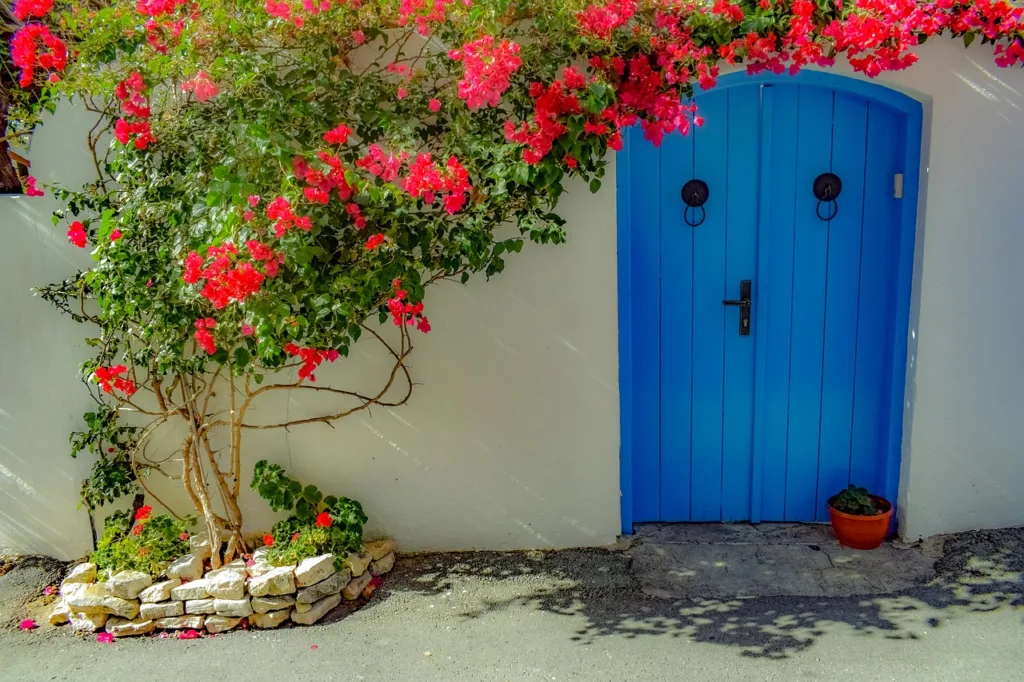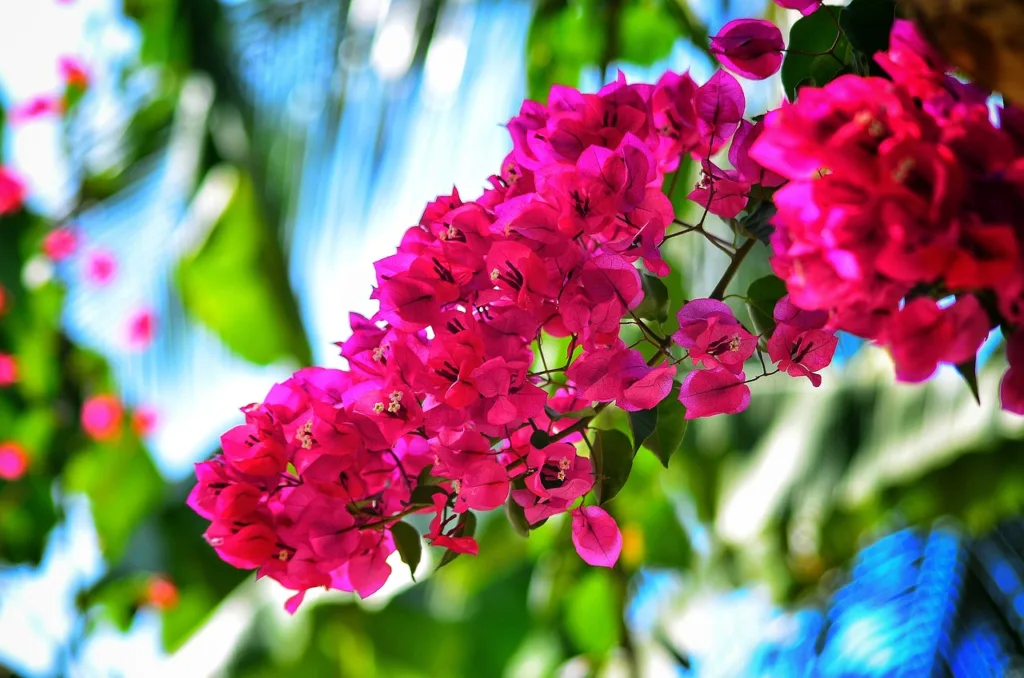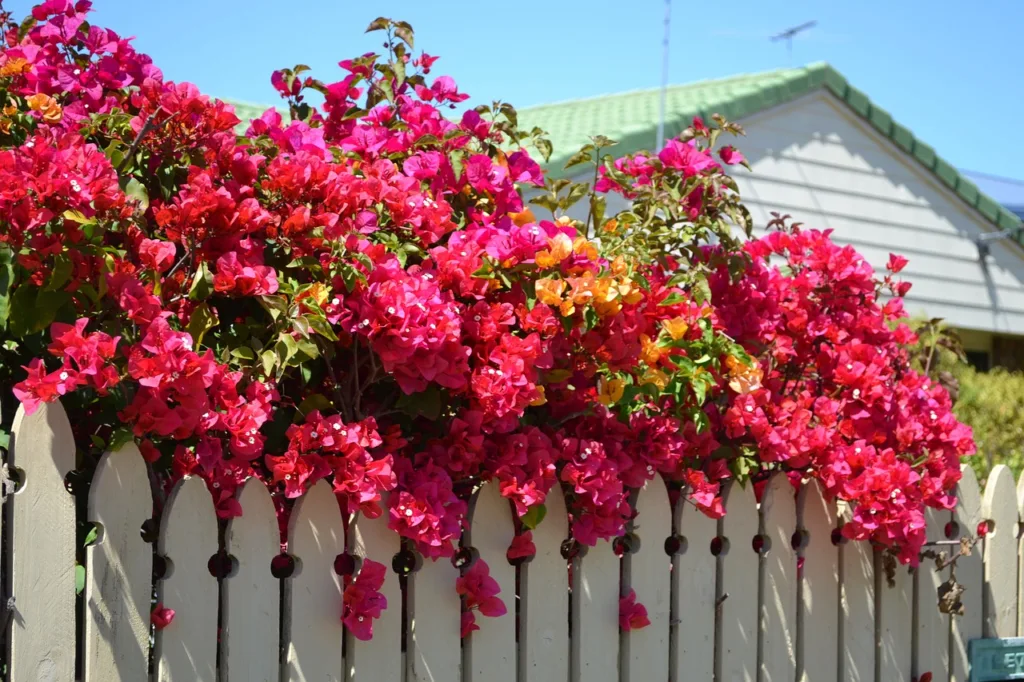Bougainvillea is a stunning and vibrant flowering plant that can bring a touch of elegance to any garden or outdoor space.
With its colorful bracts and lush green leaves, it is no wonder why bougainvillea is a popular choice among gardeners.
However, growing and caring for bougainvillea requires some knowledge and attention. In this comprehensive guide, we will explore everything you need to know to successfully grow and care for bougainvillea plants.
What is Bougainvillea
Bougainvillea is a genus of flowering plants known for its vibrant and showy bracts, which are often mistaken for flowers.
Native to South America, particularly Brazil, these plants have become popular ornamental choices in various climates worldwide. Bougainvillea belongs to the Nyctaginaceae family and includes several species and hybrids.
Bougainvillea’s attractive and long-lasting branches make it a favorite for adding color to gardens, landscapes, and containers in warm climates.
Its adaptability, drought tolerance, and climbing nature contribute to its popularity among gardening enthusiasts.
| Attribute | Details |
|---|---|
| Botanical Name | Bougainvillea |
| Common Names | Paper Flower, Bougainvillea |
| Family | Nyctaginaceae |
| Plant Type | Ornamental Vine/Shrub |
| Sun Exposure | Full Sun |
| Soil Type | Well-Draining |
| Soil pH | Slightly Acidic to Neutral |
| Flower Color | Varied (Bracts, not true flowers) |
| Bloom Time | Seasonal, May Vary |
| Height | Up to 30 feet (varies by species) |
| Toxicity | Low toxicity, potential skin irritant |
| Hardiness Zones | 9-11 (varies by species) |
| Native Area | South America |

Choosing the Right Bougainvillea Variety
Before we delve into the details of growing and caring for bougainvillea, it is important to choose the right variety for your specific needs and climate.
Bougainvillea comes in an array of colors, including vibrant shades of pink, purple, red, orange, and yellow. Some common varieties include “Barbara Karst,” “Imperial Delight,” and “Singapore White.”
When selecting a bougainvillea variety, consider the following factors:
Climate: Bougainvillea thrives in warm, tropical, and subtropical climates. If you live in an area with cold winters, choose a variety that is hardy and can withstand colder temperatures.
Size: Bougainvillea can grow up to 20 feet in height and spread up to 10 feet wide. Consider the available space in your garden when selecting a compact or more sprawling variety.
Flower Color: Bougainvillea offers a wide range of vibrant flower colors. Choose a variety that complements your garden’s overall color scheme.
Once you have chosen the right bougainvillea variety, it’s time to delve into the details of growing and caring for this beautiful plant.
Planting Bougainvillea
To ensure the successful growth of bougainvillea, it is important to plant it in the right location and provide the optimal growing conditions. Here are the steps to plant bougainvillea:
Selecting the Planting Area: Bougainvillea loves full sun, so choose a location in your garden that receives at least 6 to 8 hours of direct sunlight per day. It also needs well-draining soil to prevent waterlogged roots.
Preparing the Soil: Before planting, prepare the soil by removing any weeds or debris. Bougainvillea prefers slightly acidic soil with a pH level between 5.5 and 6.5. You can test the soil pH using a soil testing kit available at garden centers.
Digging the Hole: Dig a hole that is twice as wide and deep as the root ball of the bougainvillea plant.
Amending the Soil: Mix organic matter such as compost or well-rotted manure with the excavated soil to improve drainage and enrich the soil’s nutrients.
Planting the Bougainvillea: Gently place the bougainvillea plant in the center of the prepared hole. Ensure that the root ball is level with or slightly above the ground surface.
Backfilling and Watering: Fill the hole with the amended soil mixture, gently pressing it around the roots. Water the newly planted bougainvillea thoroughly to settle the soil and promote root establishment.
Watering and Fertilizing Bougainvillea
Watering and fertilizing are crucial aspects of caring for bougainvillea plants. Here’s what you need to know:
Watering: Bougainvillea is relatively drought-tolerant once established. To determine when to water your bougainvillea, use the finger test. Insert your finger about an inch into the soil near the base of the plant.
If it feels dry, it’s time to water. Be cautious not to overwater, as it can lead to root rot. Water deeply and infrequently to encourage deep root growth.
Fertilizing: Bougainvillea plants are heavy feeders and require regular fertilization to thrive. Use a balanced, slow-release fertilizer with an NPK ratio of 10-10-10 or 14-14-14.
Apply fertilizer every 6 to 8 weeks during the growing season, following the manufacturer’s instructions. Avoid fertilizing during winter or when the plant is not actively growing.

Pruning and Training Bougainvillea
Pruning and training bougainvillea are essential for maintaining its shape, promoting blooming, and controlling its growth. Here are some tips for pruning and training bougainvillea:
Pruning: Bougainvillea can be pruned to maintain a desired size and shape. Prune during late winter or early spring before the new growth begins.
Remove any dead, damaged, or crossing branches. To encourage blooming, selectively prune the tips of branches to promote the growth of new shoots.
Training: Bougainvillea can be trained to grow on trellises, fences, or as a decorative shrub. Use soft ties or garden twine to secure the branches to the support structure. As the plant grows, guide the branches along the desired path and secure them as needed.
Dealing with Common Bougainvillea Issues
While bougainvillea is relatively low-maintenance, it can occasionally face specific issues. Here are some common problems and how to address them:
Pests: Bougainvillea can attract aphids, mealybugs, and spider mites. Regularly inspect your plants for signs of pests, such as distorted leaves or sticky residue. Use organic insecticides or insecticidal soaps to control infestations.
Diseases: Bougainvillea is generally resistant to diseases; however, it can be susceptible to fungal infections, such as powdery mildew.
Provide adequate spacing between plants to promote air circulation. If necessary, apply fungicides according to the manufacturer’s instructions.
| Caution: While Bougainvillea is generally not considered highly toxic, contact with the plant’s sap may cause skin irritation in some individuals. It’s advisable to wear gloves when handling and pruning. |
Which Place has the Best Bougainvillea Decoration
Bougainvillea is an all-around and vibrant plant that can be used for ornamental purposes in gardens, landscapes, patios, balconies, pergolas, arbors, hedges, fences, exterior walls, containers, hanging baskets, public spaces, parks, and in both commercial and residential properties.
Its climbing nature, vibrant colors, and ability to thrive in sunny conditions make it a popular choice for adding color and tropical aesthetics to a variety of outdoor spaces.
Proper care, including full sun exposure and well-drained soil, is essential to maintain its health and ensure a long-lasting ornamental effect.

Conclusion
Growing and caring for bougainvillea can be a rewarding experience, allowing you to enjoy the beauty of this vibrant plant in your garden year after year.
By selecting the right variety, providing optimal growing conditions, and following proper watering, fertilizing, pruning, and training techniques, you can ensure that your bougainvillea thrives and adds a splash of color to your outdoor space.
So, roll up your sleeves, get your gardening tools ready, and embark on the journey of cultivating and nurturing your very own bougainvillea paradise. Happy gardening!
FAQs
Is bougainvillea good for home?
Bougainvillea is a popular choice for home gardens, providing vibrant colors and a tropical feel. Ensure it receives proper sunlight and care.
How often do bougainvillea bloom?
Bougainvillea typically blooms in cycles, often in response to changes in sunlight. With proper care, they can bloom throughout the growing season.
Do bougainvilleas like sun or shade?
Bougainvilleas thrive in full sunlight. Ensure they receive at least six hours of direct sunlight for optimal growth and blooming.
Are bougainvillea flowers poisonous?
The bougainvillea flowers are not known to be highly toxic. However, it’s advisable to keep them out of reach of pets and children.
Bougainvillea glabra?
Bougainvillea glabra is a popular variety known for its vibrant colors and is commonly cultivated for ornamental purposes.

